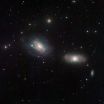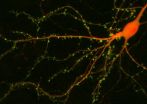(Press-News.org) This galactic grouping, found about 70 million light-years away in the constellation Sextans (The Sextant), was discovered by the English astronomer William Herschel in 1783. Modern astronomers have gauged the distance between NGC 3169 (left) and NGC 3166 (right) as a mere 50 000 light-years, a separation that is only about half the diameter of the Milky Way galaxy. In such tight quarters, gravity can start to play havoc with galactic structure.
Spiral galaxies like NGC 3169 and NGC 3166 tend to have orderly swirls of stars and dust pinwheeling about their glowing centres. Close encounters with other massive objects can jumble this classic configuration, often serving as a disfiguring prelude to the merging of galaxies into one larger galaxy. So far, the interactions of NGC 3169 and NGC 3166 have just lent a bit of character. NGC 3169's arms, shining bright with big, young, blue stars, have been teased apart, and lots of luminous gas has been drawn out from its disc. In NGC 3166's case, the dust lanes that also usually outline spiral arms are in disarray. Unlike its bluer counterpart, NGC 3166 is not forming many new stars.
NGC 3169 has another distinction: the faint yellow dot beaming through a veil of dark dust just to the left of and close to the galaxy's centre [1]. This flash is the leftover of a supernova detected in 2003 and known accordingly as SN 2003cg. A supernova of this variety, classified as a Type Ia, is thought to occur when a dense, hot star called a white dwarf -- a remnant of medium-sized stars like our Sun -- gravitationally sucks gas away from a nearby companion star. This added fuel eventually causes the whole star to explode in a runaway fusion reaction.
The new image presented here of a remarkable galactic dynamic duo is based on data selected by Igor Chekalin for ESO's Hidden Treasures 2010 astrophotography competition. Chekalin won the first overall prize and this image received the second highest ranking of the nearly 100 contest entries [2].
INFORMATION:
Notes
[1] Other much more noticeable points of light, such as the one toward the left end of the spiral arm running underneath of NGC 3169's core, are stars within the Milky Way that happen to fall by chance very close to the line of sight between our telescopes and the galaxies.
[2] ESO's Hidden Treasures 2010 competition gave amateur astronomers the opportunity to search through ESO's vast archives of astronomical data, hoping to find a well-hidden gem that needed polishing by the entrants. To find out more about Hidden Treasures, visit http://www.eso.org/public/outreach/hiddentreasures/ .
More information
ESO, the European Southern Observatory, is the foremost intergovernmental astronomy organisation in Europe and the world's most productive astronomical observatory. It is supported by 15 countries: Austria, Belgium, Brazil, the Czech Republic, Denmark, France, Finland, Germany, Italy, the Netherlands, Portugal, Spain, Sweden, Switzerland and the United Kingdom. ESO carries out an ambitious programme focused on the design, construction and operation of powerful ground-based observing facilities enabling astronomers to make important scientific discoveries. ESO also plays a leading role in promoting and organising cooperation in astronomical research. ESO operates three unique world-class observing sites in Chile: La Silla, Paranal and Chajnantor. At Paranal, ESO operates the Very Large Telescope, the world's most advanced visible-light astronomical observatory and VISTA, the world's largest survey telescope. ESO is the European partner of a revolutionary astronomical telescope ALMA, the largest astronomical project in existence. ESO is currently planning a 42-metre European Extremely Large optical/near-infrared Telescope, the E-ELT, which will become "the world's biggest eye on the sky".
Contacts
Richard Hook
ESO, La Silla, Paranal, E-ELT and Survey Telescopes Public Information Officer
Garching bei München, Germany
Tel: +49 89 3200 6655
Cell: +49 151 1537 3591
Email: rhook@eso.org
A disturbed galactic duo
2011-04-21
ELSE PRESS RELEASES FROM THIS DATE:
Obscenitease Apparel Announces Company Rebirth in 2011
2011-04-21
Obscenitease(R) Apparel, a leader in counterculture apparel, recently announced a rebirth of the company. The company will remain focused on the apparel business but with a greater emphasis on its network of fans, members and visitors to the website. The rebirth includes a fully redesigned website, videos, new blog and presence on Facebook , Twitter and other networking sites.
The company will continue to promote a culture of independent thought and expression, while interacting daily with its members. The new line of apparel is a reflection of that culture and expands ...
Common genetic variant linked to pulmonary fibrosis risk
2011-04-21
Scientists funded by the National Institutes of Health have identified a common genetic variant associated with substantially increased risk of developing pulmonary fibrosis, a debilitating and life-threatening lung condition. The genetic variant is found in a region of DNA thought to regulate the production of an important mucus-forming protein.
However, knowing the gene variant is not, by itself, enough for a test to determine who would be at risk of the disease, experts say.
This genetic variant near the mucin 5B gene, termed rs35705950, is both fairly common and ...
Electronic medical records speed genetic health studies
2011-04-21
CHICAGO --- Recruiting thousands of patients to collect health data for genetic clues to disease is expensive and time consuming. But that arduous process of collecting data for genetic studies could be faster and cheaper by instead mining patient data that already exists in electronic medical records, according to new Northwestern Medicine research.
In the study, researchers were able to cull patient information in electronic medical records from routine doctors' visits at five national sites that all used different brands of medical record software. The information ...
Genetic discovery offers new hope in fight against deadly pulmonary fibrosis
2011-04-21
A team led by researchers at National Jewish Health has discovered a new genetic variation that increases the risk of developing pulmonary fibrosis by 7 to 22 times. The researchers report in the April 21, 2011, issue of The New England Journal of Medicine that nearly two-thirds of patients with idiopathic pulmonary fibrosis or familial interstitial pneumonia carry the genetic variation. It is associated with the MUC5B gene, which codes for a mucus-forming protein.
"This discovery not only identifies a major risk factor for pulmonary fibrosis, but also points us in an ...
Stanford research moves nanomedicine one step closer to reality
2011-04-21
STANFORD, Calif. — A class of engineered nanoparticles — gold-centered spheres smaller than viruses — has been shown safe when administered by two alternative routes in a mouse study led by investigators at the Stanford University School of Medicine. This marks the first step up the ladder of toxicology studies that, within a year and a half, could yield to human trials of the tiny agents for detection of colorectal and possibly other cancers.
"These nanoparticles' lack of toxicity in mice is a good sign that they'll behave well in humans," said Sanjiv Sam Gambhir, MD, ...
A scratched coating heals itself
2011-04-21
CLEVELAND-Your 6-year-old found a nail in the garage and drew pictures across the side of your new car.
Gnash your teeth now, but researchers at Case Western Reserve University, U.S., say the fix-up may be cheap and easy to do yourself in the not-too-distant future.
Together with partners in the USA and Switzerland, they have developed a polymer-based material that can heal itself when placed under ultraviolet light for less than a minute. Their findings are published in the April 21 issue of Nature.
The team involves researchers at Case Western Reserve University ...
Neuroscientists discover new 'chemical pathway' in the brain for stress
2011-04-21
A team of neuroscientists at the University of Leicester, UK, in collaboration with researchers from Poland and Japan, has announced a breakthrough in the understanding of the 'brain chemistry' that triggers our response to highly stressful and traumatic events.
The discovery of a critical and previously unknown pathway in the brain that is linked to our response to stress is announced today in the journal Nature. The advance offers new hope for targeted treatment, or even prevention, of stress-related psychiatric disorders.
About 20% of the population experience some ...
Be Bold and Bright This Summer With Boden
2011-04-21
Summer is as good reason as any to look fabulous, whether with a full-on bright look or with a bold accessory. Go for the coveted sun-kissed, vivid Summer look with a crayon box explosion of color from Boden. From colorful kaftans to shiny shoes, the new Summer collection will brighten your look, cheer up your wardrobe and put a smile on those around you.
Be beautiful and feel like a modern princess with Piazza Dress. The neck detail worthy of Cleopatra and the natural slubbiness of silk make it uniquely alluring. Top your dress off with the Printed Silk Scarf, its light-weight ...
Scientists prove new technology to control malaria-carrying mosquitoes
2011-04-21
Scientists at Imperial College London and the University of Washington, Seattle, have taken an important step towards developing control measures for mosquitoes that transmit malaria. In today's study, published in Nature, researchers have demonstrated how some genetic changes can be introduced into large laboratory mosquito populations over the span of a few generations by just a small number of modified mosquitoes. In the future this technological breakthrough could help to introduce a genetic change into a mosquito population and prevent it from transmitting the deadly ...
Immigrant screening misses majority of imported latent TB, finds study
2011-04-21
Current UK procedures to screen new immigrants for tuberculosis (TB) fail to detect more than 70 per cent of cases of latent infection, according to a new study published in The Lancet Infectious Diseases.
TB is caused by a bacterial infection which is normally asymptomatic, but around one in 10 infections leads to active disease, which attacks the lungs and kills around half of people affected.
Today's research showed that better selection of which immigrants to screen with new blood tests can detect over 90 per cent of imported latent TB. These people can be given ...



